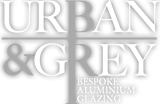Aluminium doors, just like any other product you can buy, require some care and attention in order to guarantee a long, healthy lifespan. How you go about maintaining your aluminium frames will vary according to your location and other specific requirements. Continue reading this brief guide for everything you need to know about getting the most value out of your aluminium doors.
How to clean aluminium doors
Keeping your aluminium door frames clean is a quite simple procedure. You’ll need very little specialist equipment, if any. In most cases the job can be completed using the most basic elements: water and soap combined with a soft sponge or cloth. Note that in this instance soap is a mild detergent, rather than a bar of the type you keep by the sink.
For more in-depth information about cleaning requirements, we have a special aluminium door cleaning guide for you to read, prepared previously.
Tip: Sometimes door and window installers and manufacturers specify unique cleaning requirements or guidelines, though these are generally uncommon. They are usually reserved for properties which have special environmental concerns such as significant local marine or saltwater presences, or an excess of atmospheric pollution, for example. Stick to these guidelines if they are provided and keep a record of your cleaning activities. This way you will ensure you have evidence of your eligibility for any product guarantee/warranty.
Dealing with scratched aluminium
Beyond minor marks and scruffs (which can usually be worked away using non-abrasive liquid cream or paraffin cleaner) sometimes there are deeper scratches left in the surface of aluminium frames. When the scratch is deep enough to pass the finish layer into the raw aluminium itself, a chemical process of oxidation occurs which seals the scratched area, preventing further corrosion.
However, this kind of damage is very tricky to repair. The scratch is often visible even after the most careful and thorough of paint jobs. Consequently, the going advice in this situation (and one we echo wholeheartedly) is to let it go: live with the scratch, in the knowledge that this little mark won’t affect the lifespan of the frame.
What to avoid when cleaning aluminium
There are a number of substances you should specifically avoid when working with aluminium. These are mainly comprised of strong solvents or solutions which may contain:
- Chlorine
- Esters
- Hydrocarbons
- Ketones
… and any other products known to be particularly abrasive.
On the other hand, in aluminium frames which have an anodised finish (as opposed to painted), stubborn marks can often be dealt with by using an ink rubber/eraser.
Maintaining bi-fold and sliding doors
Bi-fold or sliding aluminium doors require a bit of extra maintenance on top of traditional door frames. That’s because they use tracks and runners or rollers to open and close, and those tracks need to be kept clear and clean to ensure full functionality.
Try to take the time when using them to check for and remove any obstacles, such as stones or other debris, which may be blocking the track. Routinely hoovering the track – only once per month – should help to prevent any short or long term damage. You can further boost their longevity by lubricating the track every once in a while using a silicone spray or similar.
Tip: do not in any circumstances try to force a unit that isn’t operating properly into performing. If you’re having some difficulty with the moving parts of your doors – and the above solutions are bringing no success – then something could be seriously wrong. You may need a specialist to inspect the unit and suggest appropriate next steps. This is important because attempting to force the unit and fix it yourself can cause breakage which will not be covered by your product warranty.
Upkeep of locking systems
The smaller ironmongery parts which make up locking mechanisms generally require very little attention, as they are manufactured for long-term performance.
Typically, optimum performance of locks can be guaranteed by applying a few drops of acid-free oil (like K-40, used on sewing machines, for example) to the moving parts. Keep the locking cylinder clean and lubricated by applying oil to your keys and moving them in and out of the cylinder around every three months.
Only in extremes, such as coastal areas where weather conditions can erode their performance, will substantial extra care be needed. In these circumstances, the gaps between oiling applications should be reduced significantly. In areas with very drastic wet and cold weather, replacement of external parts will most likely be needed after every few years.
How often should I perform maintenance work on aluminium doors?
The intervals at which you give your aluminium door frames a deep clean is largely subjective, depending upon how important the spotless presentation of your property is to you. Another factor is the presence of atmospheric hazards like pollution, which can necessitate a more regular cleaning schedule. In such areas, the maximum recommended interval is about once per three months. Further away from urban zones into rural and quiet residential zones, you can usually get away with cleaning only around once per year.
To ensure the smooth operation of your door, especially when it has moving parts like tracks to slide on, a check-up and clean-out every three months is also recommended.
Summary
We hope you find this guide useful when it comes to maintaining the look and feel of the aluminium doorframes around your home. If you have any doubts, questions or queries about maintaining aluminium products, we’re eager to help out. Don’t hesitate to get in touch.
